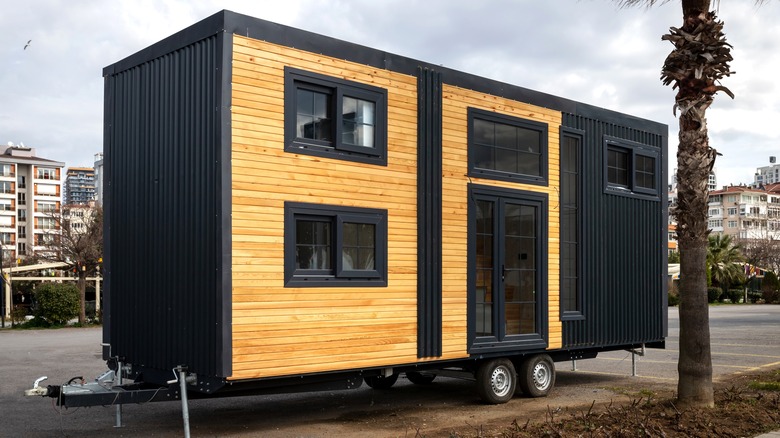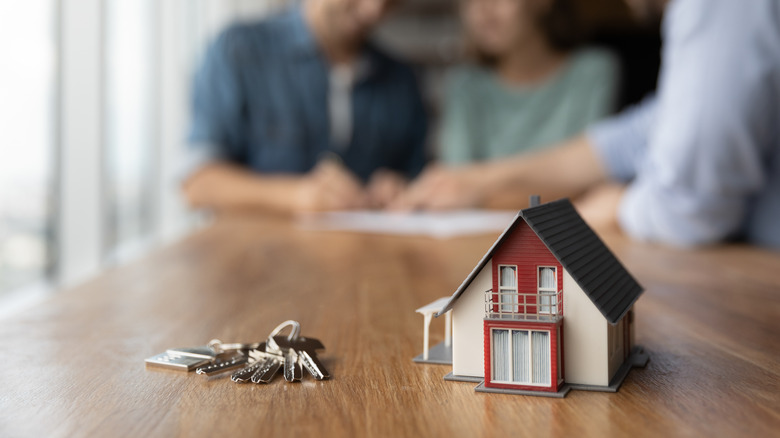Paying Rent Vs Building A Tiny House: Is One Actually More Affordable?
Finding affordable housing seems to be increasingly difficult, no matter where you live. Most people who rent simply can't afford to buy their own home because of the massive up-front costs. In fact, there has been an increase in retirees who choose renting over owning a home.
Unfortunately, tiny homes aren't legal in every state. However, changes in zoning laws and shows like "Tiny House Nation" have led many renters to turn to building living spaces that are under 400 square feet to gain financial freedom. But is it really more affordable than rent? The answer is a bit complex because it depends on how you define "more affordable." Generally, building a tiny home will save you more money than renting in the long run; however, you will need to invest a significant amount up front to make it happen. In addition, you can't build a tiny home just anywhere, so you will need to be aware of local zoning and building laws before investing in a tiny home.
When renting, you have to consider the ongoing costs of living that would be different in a tiny home, including the actual rent, any processing fees your landlord charges, utilities, parking, and insurance. With renting, these costs may fluctuate, but generally, you can expect them to remain consistent over time. With a tiny home, you won't have to pay rent, but you will have to pay for the cost of building it, the location, and utilities. Depending on your area, you could buy land, build on family land, or rent a lot. Ultimately, you will need to weigh the ongoing costs of renting against the up-front costs and ongoing costs of building and living in a tiny home.
Up-front costs of building a tiny home
On the surface, building a tiny home is appealing if you want to become a homeowner at a lower cost. Generally, tiny homes allow you to gain financial freedom compared to renting without the massive price tag of a large home. However, there are still downsides to consider before making the switch to a tiny house. Of course, there are plenty of benefits as well, especially if you want to live a sustainable or minimalist lifestyle.
If tiny living is appealing to you, determine if it is plausible in your state, county, and city. Not all states allow tiny homes, and some only allow tiny homes on foundations. Your county and city may also have limitations on building that require additional costs when obtaining permits and licensing for building. You can expect to pay between $150 and $7,500 in permits alone, according to Angi, depending on your location and the type of permits you need.
After determining where you can actually place a tiny home, you need to decide if you're going to buy land or rent a lot that allows tiny homes. The average cost of land in the United States is about $19,000 per acre, according to LandSearch. Meanwhile, depending on your location, lot rent could cost between $200 and $1,000 per month, per US Legal Forms. Of course, the cost of building is the biggest hurdle you will have to get over when investing in a tiny home. RubyHome found that the average cost of buying or building a tiny home in 2024, including materials, labor, utilities hook-ups, and furniture, was $67,000, with most falling between $35,000 and $80,000.
The ongoing costs of tiny living versus renting indefinitely
The costs of building a tiny home can seem daunting, although they are still much lower than buying a typical home. You may be able to finance the costs of building a tiny home to make the initial investment more affordable, but then you will need to consider the loan payments in your ongoing costs. You will most likely have to take out a personal loan rather than a mortgage to pay for a tiny home, which can cost up to $2,000 per month, depending on the amount and loan terms, but the loan will last only up to five years instead of up to 30 years. Other ongoing costs include insurance, taxes, maintenance, and utilities, which could reach up to $1,000 per month.
So how does that actually compare to renting? The national average cost of rent in 2025 is $1,750, according to RentCafe, but it can be significantly higher depending on your location. The lowest average rent by state is $1,071 in Oklahoma, with the highest reaching $2,892 in Massachusetts. In addition, utilities can range from $134 per month in a studio apartment to over $350 per month in a four-bedroom, per Apartment List. Other ongoing costs include insurance, parking, maintenance, and rent increases.
Ultimately, with a tiny home, you're looking at some hefty up-front costs, coupled with the potential of a loan payment for five years, but after the initial cost is paid off, you're left with minimal ongoing costs compared to renting.


